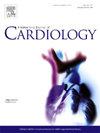Temporal trends (2003–2018) of in-hospital and 30-day mortality in patients hospitalized with acute heart failure
IF 3.2
2区 医学
Q2 CARDIAC & CARDIOVASCULAR SYSTEMS
引用次数: 0
Abstract
Background
Limited temporal data on in-hospital mortality trends of patients hospitalized with acute heart failure (AHF) have been reported. We evaluated whether, in AHF hospitalized patients, the rate of in-hospital and 30-day mortality, and 30-day re-hospitalization for AHF have changed in the past 15 years.
Methods and results
We examined administrative data from the Lombardy region, Italy and analysed data of all adults hospitalized for AHF from 2003 to 2018. Patients were stratified according to the hospitalization period: 2003–2006; 2007–2010; 2011–2014; 2015–2018. Primary endpoint was the comparison of in-hospital mortality rates among periods. Secondary endpoints were 30-day mortality rates and temporal trends of re-hospitalization for AHF. During this period, 414,164 hospitalizations with a primary diagnosis of AHF were identified, involving 286,028 patients aged 18 and older. In-hospital and 30-day mortality in the entire cohort showed a progressive increase over time (from 6.7 % to 8.5 % and from 12.4 % to 14.5 %, respectively). Thirty-day re-hospitalization for AHF was 2 %, showing a progressive decrease over the years. However, patient’ age and complexity increased in the most recently hospitalized patients. After adjusting for major confounders, in-hospital and 30-day mortality risks were similar moving from one study period to the next (relative risk for trend 1.00 [95 % CI 0.99–1.01] and 1.00 [95 % CI 0.98–1.01], respectively), while that of 30-day AHF re-hospitalization decreased progressively (hazard ratio for trend 0.86 [95 % CI 0.84–0.88]).
Conclusions
In our study, the increasing age and complexity of patients largely accounted for the continued rise in early mortality observed in patients hospitalized with AHF.
急性心力衰竭住院患者的院内死亡率和 30 天死亡率的时间趋势(2003-2018 年)。
背景:有关急性心力衰竭(AHF)住院患者院内死亡率趋势的时间数据报道有限。我们评估了急性心力衰竭住院患者的院内死亡率、30 天死亡率和 30 天再住院率在过去 15 年中是否发生了变化:我们研究了意大利伦巴第大区的行政数据,并分析了2003年至2018年期间因AHF住院的所有成年人的数据。根据住院时间对患者进行了分层:2003-2006 年;2007-2010 年;2011-2014 年;2015-2018 年。主要终点是比较不同时期的院内死亡率。次要终点是 30 天死亡率和 AHF 再住院的时间趋势。在此期间,共确定了 414,164 例主要诊断为 AHF 的住院病例,涉及 286,028 名 18 岁及以上的患者。随着时间的推移,整个组群的住院死亡率和30天死亡率逐渐上升(分别从6.7%上升到8.5%和从12.4%上升到14.5%)。AHF的30天再住院率为2%,逐年下降。不过,最近住院的患者年龄和病情复杂程度有所增加。调整主要混杂因素后,从一个研究阶段到下一个研究阶段,院内和30天死亡率风险相似(趋势相对风险分别为1.00 [95 % CI 0.99-1.01]和1.00 [95 % CI 0.98-1.01]),而AHF 30天再住院风险逐渐降低(趋势危险比为0.86 [95 % CI 0.84-0.88]):在我们的研究中,患者年龄和病情复杂程度的增加在很大程度上导致了AHF住院患者早期死亡率的持续上升。
本文章由计算机程序翻译,如有差异,请以英文原文为准。
求助全文
约1分钟内获得全文
求助全文
来源期刊

International journal of cardiology
医学-心血管系统
CiteScore
6.80
自引率
5.70%
发文量
758
审稿时长
44 days
期刊介绍:
The International Journal of Cardiology is devoted to cardiology in the broadest sense. Both basic research and clinical papers can be submitted. The journal serves the interest of both practicing clinicians and researchers.
In addition to original papers, we are launching a range of new manuscript types, including Consensus and Position Papers, Systematic Reviews, Meta-analyses, and Short communications. Case reports are no longer acceptable. Controversial techniques, issues on health policy and social medicine are discussed and serve as useful tools for encouraging debate.
 求助内容:
求助内容: 应助结果提醒方式:
应助结果提醒方式:


